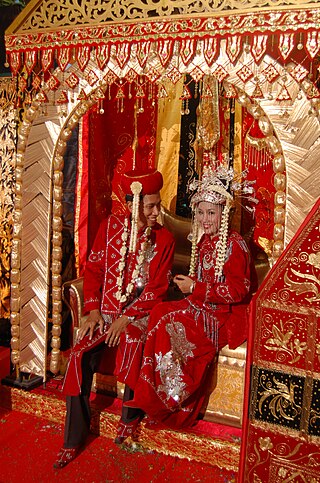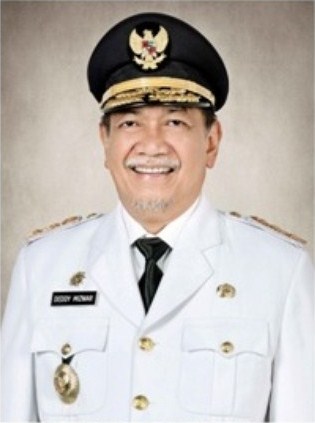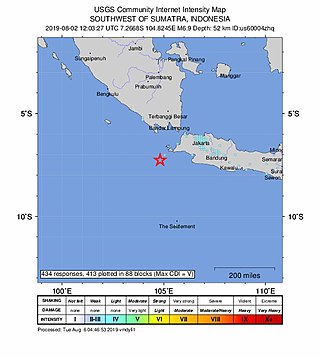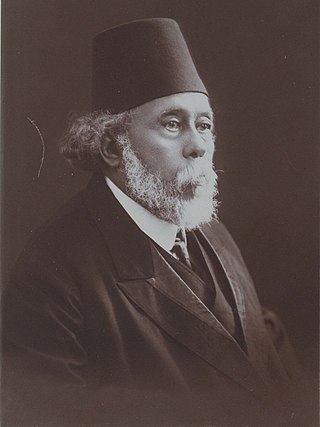
Jakarta, officially the Special Capital Region of Jakarta and formerly known as Batavia until 1949, is the capital and largest city of Indonesia. Lying on the northwest coast of Java, the world's most populous island, Jakarta is the largest metropole in Southeast Asia, and serves as the diplomatic capital of ASEAN. The Special Capital Region has a status equivalent to that of a province and is bordered by two other provinces: West Java to the south and east; and Banten to the west. Its coastline faces the Java Sea to the north, and it shares a maritime border with Lampung to the west. Jakarta's metropolitan area is ASEAN's second largest economy after Singapore.

Istiqlal Mosque in Jakarta, Indonesia is the largest mosque in Southeast Asia and the ninth largest mosque in the world in terms of worshipper capacity. Built to commemorate Indonesian independence, this national mosque of Indonesia was named "Istiqlal", an Arabic word for "independence". The mosque was opened to the public on 22 February 1978. Within Jakarta, the mosque is positioned next to Merdeka Square, the Jakarta Cathedral (Catholic), and also of the Immanuel Church (Reformed).

Malay houses refer to the vernacular dwellings of the Malays, an ethno-linguistic group inhabiting Sumatra, coastal Borneo and the Malay Peninsula.

North Jakarta is one of the five administrative cities which form Special Capital Region of Jakarta, Indonesia. North Jakarta is not self-governed and does not have a city council, hence it is not classified as a proper municipality. It contains the entire coastal area within the Jakarta Special Capital Region. North Jakarta, along with South Jakarta is the only two cities in Jakarta to border Banten and West Java. It is also the only city of Jakarta with a coastline and thus not landlocked. North Jakarta, an area at the estuary of Ciliwung river was the main port for the kingdom of Tarumanegara, which later grew to become Jakarta. Many historic sites and artefacts of Jakarta can be found in North Jakarta. Both ports of Tanjung Priok and historic Sunda Kelapa are located in the city. The city, which covers an area of 139.99 km2, had 1,645,659 inhabitants at the 2010 census and 1,778,981 at the 2020 census; the official estimate as at mid 2023 was 1,801,963. It has its administrative centre in Tanjung Priok.

Betawi people, or Batavians, are an Austronesian ethnic group native to the city of Jakarta and its immediate outskirts, as such often described as the native inhabitants of the city. They are the descendants of the people who inhabited Batavia from the 17th century onwards.

Cilincing is a historic neighborhood and administrative district (kecamatan) on the coast of North Jakarta Administrative City, Indonesia. It is sandwiched between the Port of Tanjung Priok to the west and River Titram to the east. Cilincing has been for some decades one of the districts of North Jakarta which in turn encompasses as far as Marunda and some non-coastal hinterland.

The architecture of Indonesia reflects the diversity of cultural, historical, and geographic influences that have shaped Indonesia as a whole. Invaders, colonizers, missionaries, merchants, and traders brought cultural changes that had a profound effect on building styles and techniques.

Deddy Mizwar is an Indonesian actor, film director and politician, born of an Indo (Dutch-Betawi) father and Betawi-Bugis mother. He is the Chairman of Indonesia's National Film Advisory Board and former Vice Governor of West Java. He also ran for governorship of the province in the 2018 election. His 2010 film How Funny was selected as the Indonesian entry for the Best Foreign Language Film at the 83rd Academy Awards, but it didn't make the final shortlist.

Rumah adat are traditional houses built in any of the vernacular architecture styles of Indonesia, collectively belonging to the Austronesian architecture. The traditional houses and settlements of the several hundreds ethnic groups of Indonesia are extremely varied and all have their own specific history. It is the Indonesian variants of the whole Austronesian architecture found all over places where Austronesian people inhabited from the Pacific to Madagascar each having their own history, culture and style.

Colonial buildings and structures in Jakarta include those that were constructed during the Dutch colonial period of Indonesia. The period succeeded the earlier period when Jakarta, governed by the Sultanate of Banten, were completely eradicated and replaced with a walled city of Batavia. The dominant styles of the colonial period can be divided into three periods: the Dutch Golden Age, the transitional style period, and Dutch modernism. Dutch colonial architecture in Jakarta is apparent in buildings such as houses or villas, churches, civic buildings, and offices, mostly concentrated in the administrative city of Central Jakarta and West Jakarta.

Ahmad Syech Albar, better known as Ahmad Albar, is an Indonesian rock musician and vocalist of mixed ethnic Arabic and Javanese descent. He is the founding member of God Bless.

The Luar Batang Mosque is one of the oldest mosques in Jakarta, Indonesia, located in the area of Pasar Ikan in North Jakarta on the west side of the Sunda Kelapa Harbor. The mosque was built in the 18th century and named after Luar Batang, in accordance with the nickname of a sacred guardian of Islam, Habib Luar Batang, where his shrine is also located.

Sandung or sandong is the ossuary of the Katingan, Ngaju, and Pesaguan people native to southern and central Kalimantan in Indonesia who still remain of the Kaharingan religion. The sandung is an integral part of the Tiwah ceremony of the Ngaju people, which is basically a secondary burial ritual where the bones of the deceased are taken from the cemeteries, purified, and finally placed in a sandung.

A balairung is a village hall of the Minangkabau people of West Sumatra, Indonesia. It has a similar architectural form to the rumah gadang, the domestic architecture of the Minangkabau people. Whereas a rumah gadang is a proper building, the balairung is a pavilion-like structure used solely for holding a consensus decision-making process in the Minang society.

The 2019 Sunda Strait earthquake occurred on the night of 2 August 2019, when a magnitude 6.9 earthquake rattled Sunda Strait at a moderate depth of 52.8 kilometres. The epicentre was located 214 km from Bandar Lampung, the capital of Lampung and 147 km west of Sumur, Pandeglang Regency. The earthquake struck with a maximum intensity of VI (Strong). The earthquake prompted a tsunami warning in the area, with authorities urging coastal residents to immediately evacuate to higher grounds.

Sayyid Abdullah bin Alwi Alatas was a Dutch East Indies merchant, landlord, and philanthropist of Arab descent from the Ba 'Alawi sada clan. Alatas is also the owner of the Cikini House after it was bought from Raden Saleh. He also inherited another eccentric house, such as a house built by a Frenchman in an Islamic style.

The Forum Betawi Rempug (FBR) is a Betawi mass organization (ormas) based in Jakarta. The group was established on July 29, 2001, by two Betawi kyais Fadloli El Muhir and Lutfi Hakim. The FBR aims to champion the political rights of the Betawi people, an indigenous but marginalized ethnic group based in Jakarta. Today, the FBR has set up over 300 branches in the Jakarta metropolitan area (Jabodetabek) with each at least 100 active memberships.

The Catholic Church of St. Servatius in Kampung Sawah, Bekasi, West Java is a parish consisting of mostly Catholic Christians from Betawi in the Kampung Sawah area. Betawi culture is still shown by church members through the use of Betawi language and vocabulary which is derived from the Malay language. In Kampung Sawah itself the Betawi culture has survived even though some parts of it have become extinct. One of the Betawi cultural rituals that have survived, although undergoing changes, is bebaritan or what is currently known as the sedekah bumi or earth's Almsgiving. Uniquely, this ritual is currently carried out at the Parish of Santo Servatius Kampung Sawah.
Rumah Panggung is one type of traditional Betawi house whose floor is raised from the ground using wooden poles. This house is different from a Rumah Darat that sticks to the ground. Betawi houses on stilts are built in coastal areas with the aim of dealing with floods or tides. Meanwhile, stilt houses located on the banks of rivers such as in Bekasi are not only built to avoid flooding, but also for safety from wild animals.


















